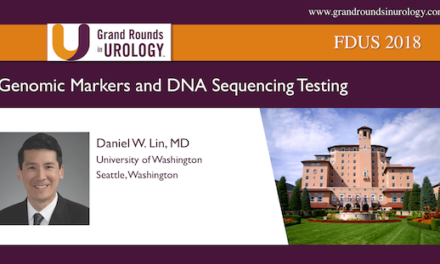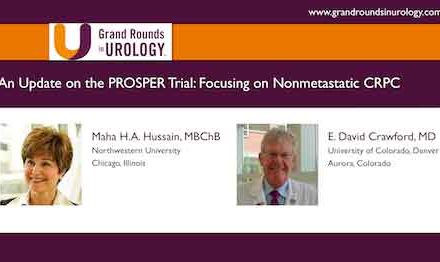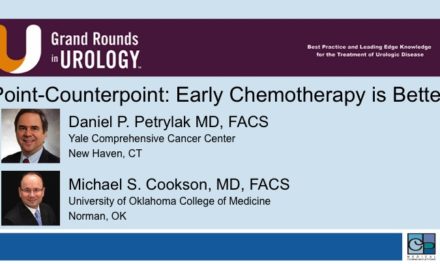Dr. Thomas Keane spoke at the 24th International Prostate Cancer Update on Friday, February 21, 2014 on “Androgen Deprivation Therapy (ADT) with GnRH Antagonists.” In his presentation, Dr. Keane discusses ADT with GnRH antagonists and efficacy benefits of time to castration and PSA suppression, PSA progression-free survival, and overall survival.
Presentation:
Keywords: GnRH antagonists, cardiovascular, castration, degarelix, leuprolide, PSA, suppression, FSH, testosterone
How to cite: Keane, Thomas E. “Androgen Deprivation Therapy (ADT) with GnRH Antagonists” Grand Rounds in Urology. January 13, 2015. Accessed Nov 2024. https://dev.grandroundsinurology.com/prostate-cancer-thomas-keane-adt/
Transcript
Androgen Deprivation Therapy (ADT) with GnRH Antagonists
David asked me to review androgen deprivation therapy with GnRH antagonists and that is what we are going to do. We are going to look at the efficacy benefits in terms of time to castration and PSA suppression, PSA progression-free survival, overall survival. We are also going to describe the safety profile. But before we do that, there has been a lot of debate and a lot of discussion at numerous meetings about what is considered a reasonable castrate level. The questions have been raised by these two authors, namely Juan Morote and then followed up, two years later by Perachino. Both of these authors showed that those patients who did not need nadir down to a level of 20 or less did significantly worse than those patients who did. In Morote’s case, it was almost four years difference in the time to androgen-independent progression.
Everybody has said, and they are correct, these are purely hypothesis generating. Morote’s is 73 patients, Perachino’s is 129 patients. So now, here is some data from a large trial and I am very grateful to Larry Klotz for actually giving me this slide. This, he presented at the URS meeting a couple of months ago and it is basically the Canadian study which looked at the intermittent versus continuous arm and this is the patients who were in the continuous arm who were followed up for one year and had three separate estimates of their testosterone levels once they were castrated. And, once again, he has shown a distinct difference in the patients who progressed from those who were below 20 versus those who were at 50, and more. So, I think we have had hypotheses for the last two papers.
This is the first proof. It is in a large paper and it is a large number of patients, so I think we certainly should be looking very closely at what the castrate level is.
I am going to talk about how GnRH antagonists differ from the agonists and, basically, as you look at this slide, if the antagonists had come along first, we would not have had agonists. But, Jack Shelley made the agonists because he was able to replace one amino acid. If you want to make an antagonist, you have to replace seven and these are the various different antagonists. There were two, abarelix was tried originally. We all know that story. There was a 25 percent escape rate at one year; there was some anaphylaxis in it and it did not stand the test of time. It is still around and some people still use it. The difference, we know the mechanism of action difference, basically the agonists. There is a surge in FSH and LH and testosterone before suppression is reached. We know there are microsurges and we know that the FSH is suppressed, but there can be some escapes, or some differences, and I will show you some data on that in a minute. The GnRH antagonists, on the other hand, are immediate suppressors of FSH, LH and testosterone, no microsurges, and there is prolonged suppression and, in my opinion, better suppression of FSH and we will talk about that.
So, I am going to go through the pivotal phase III trial CS21 and CS21A which was the extension trial, and this was the study, it was a randomized phase III trial comparing degarelix with leuprolide. They started off with a 240 mg loading dose of degarelix and then there were two different maintenance doses assessed, primarily an 80 mg and a 160 mg and, to cut a long story short, the 80 mg did everything the 160 mg did, so the 80 mg became the maintenance dose of choice, and that was compared to a once-monthly dose of leuprolide, given for the year.
Now, the primary endpoint was the cumulative probability of testosterone reaching less than 50 ng/dl of all monthly measurements from day 28 through day 364, which is the FDA’s definition of what is considered adequate for castration. It was a non-inferiority trial.
The secondary endpoints were interesting: the proportion of patients with testosterone surge; those with testosterone of less than 50 ng/dl at day three; the percentage change in PSA from baseline to day 28; severity of adverse events and their frequency; and the last one was particularly interesting, the frequency of PSA progression.
This is the original data, you can see the three groups and, basically, there was not a whole lot of difference between them. They were well matched in terms of disease. There were some load lease and score patients and they were primarily from Europe, when elderly patients with prostate cancer were being treated with hormonal therapy. So, here is the data. Basically, at the first 28 days, you can see the surge from the leuprolide up above and then you can see 53 percent of patients rendered castrate within 24 hours. Ninety-six percent of patients rendered castrate in three days. The two curves meet at around day 28. As you look at the PSA reduction, it was significantly less with the leuprolide. It took 56 days for the PSAs to come together. I should say people were allowed to use nonsteroidal antiandrogen on the induction of LHRH agonists and only 11 percent of the physicians chose to do so.
But, interestingly, when we looked at PSA progression at the end of one year, there was a 33 percent difference between the patients on the degarelix versus the patients on leuprolide. Now, this was not uniform across the whole group. The patients who saw the best benefit were those patients who had a PSA between 20-50 and those patients who had metastatic disease. And, interestingly, this is data from Fritz Schroeder. He looked at the alkaline phosphatase levels and he found that there was a significantly lower level reached with the antagonists versus the agonists, and he found that at the end of one year, the patients on the agonists tended to be trending back up towards a normal level.
So, after that, the FDA then stepped in and said, “Okay, well, because of the past history, we want to make sure that the testosterone remains suppressed and we would like you to extend this study out to five years” so they did, and then they also said, “And while you’re at it, we’d also like you to convert the patients on the leuprolide over to the degarelix so everybody is on it so we can follow a larger group of patients.”
And, this is what happened: When they converted the patients on the leuprolide over to degarelix, there was a significant drop in the FSH, a further drop of 63 percent. Even though it was low, it went lower.
Now, I want to take a little aside here. FSH, we are not too sure exactly what is going on about the FSH story. It is kind of like we were five years ago with the testosterone story. Nobody knew that testosterone was being produced by the prostate cells. And just because we do not know what the effect is, it does not mean that there is not an effect. This is an analysis. This is a paper by Radu in the New England Journal in 2010 where he looked at samples from 773 patients with prostate cancer. All samples expressed the FSH receptor, whereas normal tissue had no receptor expression.
Then he stained some of the tissue samples and he stained them red, which was the FSH receptor, green, which was the vascular endothelial cells, and there was colocalization and the area of the maximum FSH receptors was around the blood vessels. He also then looked at the tumors versus the normal tissue and there was an increased preponderance of blood vessels in the tumor. That makes sense. Then, he went to look to see where is the biggest increase of vessels within the tumor, and it was at the leading edge of the tumors. If you are a military fan, if you are going to go to war and you are going to invade, you had better make sure you have good lines of supply. Napoleon found that out. Same thing here, if you are going to invade, you had better make sure that you have a good supply of blood because you are going to need it, at least your cells are.
So, getting back to the study that I was talking about, when they converted the patients who were on the leuprolide over to degarelix, the curve switched. You can see the PSA progression-free hazard ratio changed and it was a significant change. So, in other words, the patients who were failing, the curves improved. The ones who were on the leuprolide, once they were crossed over, they improved. Now, I wish they had not crossed them over because I would love to have seen what would have happened had the study been continued out and the patients had remained on leuprolide.
Okay, adverse events: Basically, the adverse events are similar apart from one significant factor and that is injection site reaction. There was a 34 percent injection site reaction on the loading dose, which dropped down to 4 percent throughout the study.
There was no patient who left the study because of the injection site reaction, but it does remain a problem. So, overall from CS21 and CS21A, compared with an LHRH agonist, degarelix produces faster castration onset and PSA suppression with no risk of clinical flare, longer PSA progression-free survival, especially in those patients who have larger volume of disease and higher PSAs. For up to five years of degarelix treatment, PSA relapse-free progress is improved after crossover from leuprolide to degarelix and the therapy is well tolerated.
Now, I want to also look at disease control and cardiovascular outcomes from a pool database analysis of the phase III clinical trials in which degarelix has been used, and how does the control of disease compare against agonists? This was achieved, this was a paper that was published, and I will go into it in a second, it was a pooled phase III analysis. Now, the key degarelix benefits have been reported from numerous phase III randomized trials. Pool data from multiple trials allows this analysis of outcomes from a large patient population. The degarelix clinical trial database has been analyzed to compare disease control parameters, disease-related side effects, and the risk of cardiovascular events.
Here are the studies which are included: There are three 12-month studies. There are three 3-month studies. The efficacy data was collected as I mentioned. When you look at the two groups, they are well balanced. They are well balanced in age. They are well balanced in locally advanced metastatic disease, and their Gleason scores. And what they found was superior overall survival was seen with the degarelix versus the LHRH agonists in all patients. However, very few patients died of prostate cancer. Most of the patients died of cardiovascular events. And also, is the risk of cardiovascular events therefore increased with LHRH agonists compared with degarelix?
Well, we know androgen-deprivation therapy is associated with an increase of cardiovascular events.
LHRH agonists have been linked to increased cardiovascular morbidity. Men with a history of cardiovascular disease are most at risk. These two agents have different mechanisms of action. Therefore the risks of cardiovascular events could be different.
Here are the patients. There were approximately 2,400 patients. There were around 1,500 on degarelix, around 840 on LHRH agonists and they could be on either goserelin or leuprolide. There were cardiovascular disease patients. There were 463 on the degarelix side, 245 on the LHRH agonist side. On the percentages, they were almost the same. Again, looking at the baseline demographics, they were well balanced and then, if you look at the whole groups, overall, in terms of any cardiovascular event, there was a distinct difference between the two groups in terms of any event and there was also a difference in terms of death.
And then when you looked at, this is the death. It does not look like much, because this is from one to one hundred, which is how it should be, but there was a small difference, which was significant. When they looked at men with a history of cardiovascular disease, however, the differences became more pronounced. Again, not massive, but almost 50 percent greater in the agonist arms, in terms of any event and also in terms of death, and this is the graph of that.
Why is this? Well, one of the theories is T lymphocytes are stimulated. They have LHRH receptors which are stimulated by the agonists and that release an increase in interferon-gamma and CD4 cells. The increased interferon-gamma causes inhibition of collagenase synthesis and CD4 side causes upregulation of collagenases, which leads to disruption of the fibrotic cap, and therefore can lead to an increased risk of thromboembolic complications.
So, the conclusions: When treated with degarelix, rather than an LHRH agonist, patients with pre-existing cardiovascular disease had significantly fewer events during the first year of treatment and had a relative risk reduction of over 50 percent.
So, overall summary: There is faster castration onset and PSA suppression, no risk of clinical flare, longer PSA progression-free survival that is timed to castration, resistant, or death, especially in those patients with larger volume disease.
Improved overall survival, improved control of skeletal metastases, which I did not go into for the sake of time, but David has a paper that he has published on that showing a reduced rate of musculoskeletal events and significantly fewer cardiovascular events. In terms of where you would put this, and again, this is not the be-all and end-all.
I believe that it is a better product for the reasons I have given you. But if you have a patient who has a history of a cardiovascular event or has active cardiovascular disease that would be someone for whom I would choose this agent.
If you have somebody who has higher volume disease, who has large volume metastases, this is something that I would consider. I did not mention the improvement of the LUTS because there are a number of small studies which show a benefit, but I did not feel that we should go into that at this point.
Thank you very much.
ABOUT THE AUTHOR
Thomas E. Keane, MD, is Professor and Chairman of the Department of Urology at the Medical University of South Carolina in Charleston. Dr. Keane specializes in managing prostate, bladder, and renal cancers.
An avid researcher, Dr. Keane has served as principal investigator or co-investigator on more than 20 major clinical and preclinical studies. Much of his work focuses on innovative concepts in translational research, including utilizing human tumor xenografts to investigate the efficacy of new therapies as they relate to GU malignancies with particular reference to cytotoxic agents, sphingolipids, and boron-containing compounds. He holds a United States patent for sphingolipid derivatives and their use.
Dr. Keane’s research has led to publication of more than 100 articles peer-reviewed in such journals as The Journal of Urology, Urologic Oncology, and the Journal of Vascular Surgery. He provides editorial services to publications ranging from Urology to the International Journal of Cancer and is co-editor of the text Glenn’s Urologic Surgery, 6th, 7th, and 8th Editions. He is an accomplished speaker, having delivered many presentations to professional societies and symposia throughout the United States and abroad.





